Post-war bombs and mines sow insecurity among people in border areas
(Baonghean.vn) - The war has been over for more than 42 years, but for the people of Nam Can commune, Ky Son district (Nghe An), it still lurks somewhere underground, behind the treetops and grass.
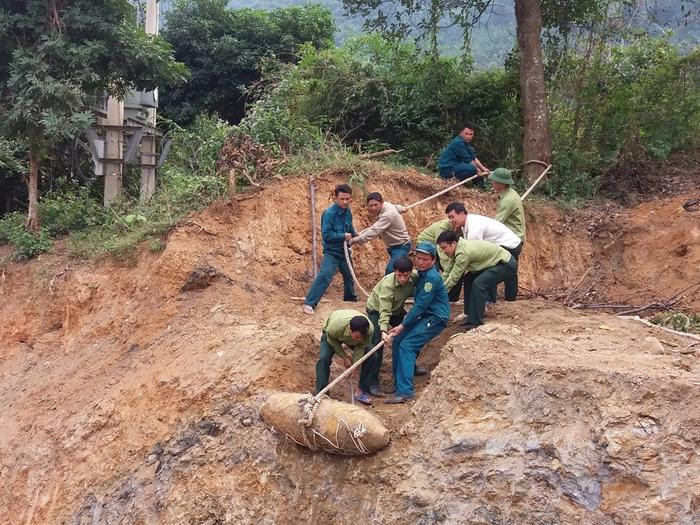 |
| The Military Command of Ky Son district is handling a bomb left over from the war discovered in Nam Can commune. Photo: Lu Phu |
Pigs can also find bombs and mines…
During the years of the resistance war against the US, National Highway 7A through the Nam Can international border gate was our army's strategic traffic route to transport human and material resources to the battlefields of Southern Laos and the South. Because of its important location, this area was often bombed and shelled by the US Air Force. Also in order to block this strategic route, in addition to conventional bombs, the US Air Force also dropped hundreds of tons of various types of jar bombs.
“At that time, all villages had to move into the mountains and forests to hide from bombs dropped by American planes. Almost every day, planes came in to bomb. At first, the bombing was normal, but in the following years, the US Air Force dropped cluster bombs and bombs to block the road. There were times when cluster bombs did not explode, spreading thickly on the ground, only clearing the road for vehicles to pass, the rest were scattered everywhere” - said Mr. Cut Man Noi (born in 1937), residing in Nong De village, Nam Can commune, former Secretary of Nam Can commune from 1965 to 1971.
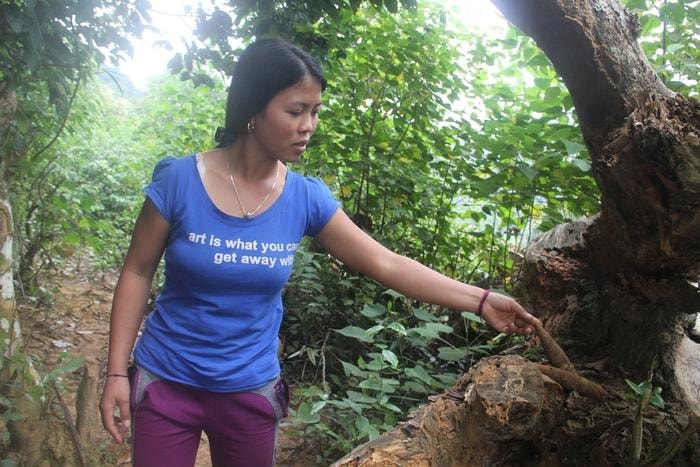 |
| The bullets were discovered by the family of Ms. Ngan Thi Quyen, residing in Noong De village, Nam Can commune, while clearing the ground to build a house. Photo: Xuan Hoa |
After the war, people from deep in the mountains and forests returned to their old villages to rebuild their houses. Trenches and bombs left behind were densely packed where people lived, and on the fields, how many bombs and bullets were left underground was something no one could count. There were times whenPeople picked up bombs and mines as if they were picking up dirt.stone, relativesCollect and wait for the government to come and collect and process. If the government doesn't come for a long time, then put it intree holes or throwsto the edge of the forest
Just like that, the people here live with bombs and mines. In Nam Can, there are all kinds of unexploded ordnance, from 12.7mm bullets, artillery shells, mortar shells, B40 - B41 shells, grenades, flares, cluster bombs, blockbuster bombs, rockets... There are so many that people say that just by digging the ground to find food, the bombs and mines are exposed, sometimes the pigs even "help" roll cluster bombs down the hillside to people's houses.
“There are many, one day pigs were digging for food, cluster bombs came up and rolled down right under the house. Now there is a large hill with good soil but there are too many bombs to dare to clear it to plant trees. Up there you have to walk carefully, not to mention digging,” said Ms. Tha Me Thon, resident of Noong De village, Nam Can commune.
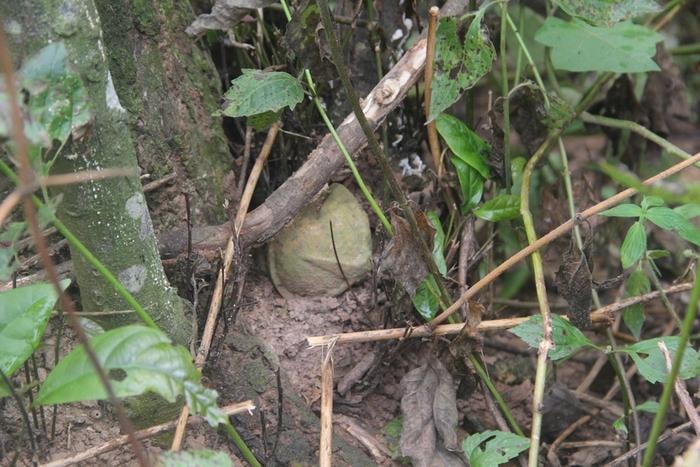 |
| The remaining cluster bombs in the residential area were picked up by the people of Nam Can commune and placed in tree roots, waiting for the authorities to come and destroy them. Photo: Xuan Hoa |
Recently, while leveling the ground to build the Nam Can Secondary School for Ethnic Minorities, authorities discovered a large amount of cluster bombs and artillery shells...
“These past few days, while digging the ground to prepare to build a house, I found some cluster bombs and warheads. My husband gathered them and put them at the base of a tree, waiting for the commune officials to come and collect them. Before, when digging ditches around the old house, he also found some mortar shells and B40 bullets, but my husband was afraid that the children would pick them up and play with them, so he took them and threw them away in the forest,” said Ms. Ngan Thi Quyen (born 1994), resident of Noong De village.
There are still many unexploded bombs and mines in the villages of Noong De, Khanh Thanh, Truong Son, etc. of Nam Can commune. There are so many bombs and mines that even with just one rain, the eroded land can reveal bombs and mines.
Pain from the ground
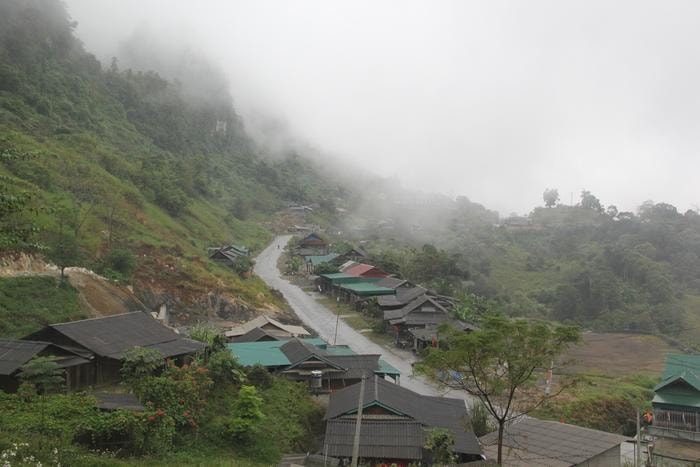 |
| Villages in Nam Can commune still face potential dangers from bombs and mines left over from the war. Photo: Xuan Hoa |
Since the end of the war, there have been four mine accidents in Nam Can commune, killing seven people and disabling one. The most recent was in 2015, when Mr. Luong Pho Mun, while clearing the fields, hit a cluster bomb that exploded, killing him on the spot. The most heartbreaking was the B41 warhead explosion in Khanh Thanh village, killing four people, including three fathers and sons in one family.
Meeting Mrs. Lo Thi Thuong, the only remaining woman in a family of three father and children who died from a B41 warhead explosion in Khanh Thanh commune. Luckily, she escaped but Mrs. Thuong was also devastated by the pain of loss.
She said that on July 14, 2007, she was working away from home when she heard the news that her husband, two sons and a neighbor's child had died from a bullet explosion. When she got home, she fainted when she saw the tragic scene of her husband with his lower body completely crushed, and her two children with many injuries lying motionless in a pool of blood. She was so heartbroken that she abandoned her old house and moved to another place to live, hoping to ease her grief.
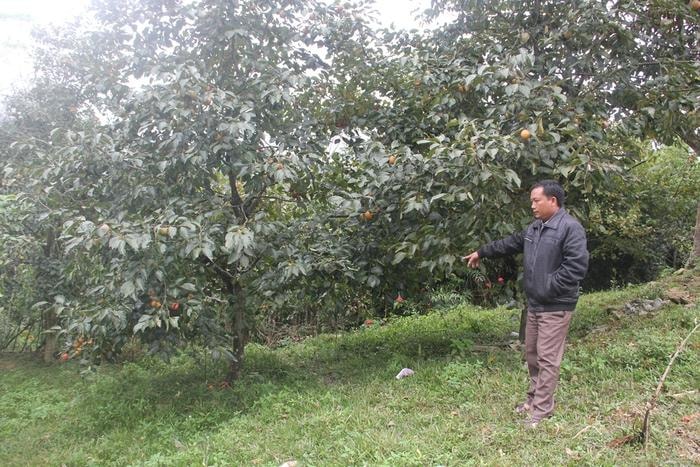 |
| The mine pits collected from the villages were buried in the grounds of the Nam Can Commune Militia Squad and rose bushes were planted on top to mark them. Photo: Xuan Hoa |
Having his only son killed in that explosion, Mr. Lo Van Xieng (born in 1964), residing in Khanh Thanh village, Nam Can commune) choked up remembering that fateful day: “It’s been 10 years but I still can’t forget. That day, he came home late from playing volleyball so he ate rice and went to Pho Thuong’s house (Mrs. Thuong’s husband) to play. While I was working at home, I suddenly heard a loud explosion so I ran over and saw Pho Thuong with half of his lower body crushed and his two sons dead and thrown in many directions. My son, who was further away, was covered in blood but still alive. I quickly hugged him and called for help from the locals and took him to the emergency room. I thought he would make it, but when we got to the hospital, he was with Mr. Thuong and his three children.”
As for Mrs. Luong Me Mun, who lives in Noong De village, who just lost her husband, the pain is still there. Now her eyesight is poor, her ears are deaf, and she is alone at her loom. In 2015, Mrs. Mun's husband and children went to the field to clear trees in preparation for the new crop. When the vast hill was almost cleared, only a small piece the size of a table remained, he told his children to gather their things and go home while he finished the work and then returned.
As the children turned around, there was a deafening explosion. They turned around and saw their father thrown off his feet and lying on the field. From then on, the field was abandoned and no one dared to work there anymore.
“That day, if there were still many uncleared areas in the field, he would not have been the only one to die. Thinking back now, I still feel chills down my spine,” said Mother Mun, her eyes red with tears.
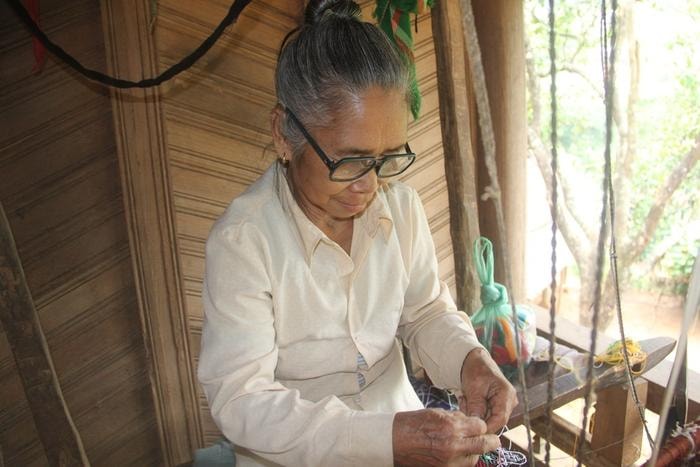 |
| Ms. Luong Me Mun, a resident of Noong De village, lost her husband when he was killed by a cluster bomb while clearing the fields two years ago. Photo: Xuan Hoa |
The pain still haunts the lives of every ethnic minority household here. Unfortunately, the government is in trouble, and the handling of remaining bombs and mines cannot be carried out thoroughly. According to Mr. Lau Ba Tong, Nam Can Commune Team Leader, except for the time when the engineers came to clear bombs and mines along National Highway 7A to widen the road, the authorities only come to handle them when people discover bombs and mines.
“Every time people build houses or work on the fields and discover bombs or mines, we report to the District Military Command to handle them. There are still many remaining bombs or mines. We sometimes use trucks to collect small ammunition discovered by people and bring them back to the commune. We handle it by digging holes, spreading plastic, putting bombs or mines in, and burying them with salt. For each hole like that, we plant a fruit tree there to mark it. Now, if we count the plants and buried holes, there must be a ton of bombs or mines."
I hope that if the authorities cannot clear bombs on the hills, they will clear them in residential areas. So that people can live and work in peace and there will be no more tragic deaths" - Mr. Lau Ba Tong said.
Xuan Hoa
| RELATED NEWS |
|---|

